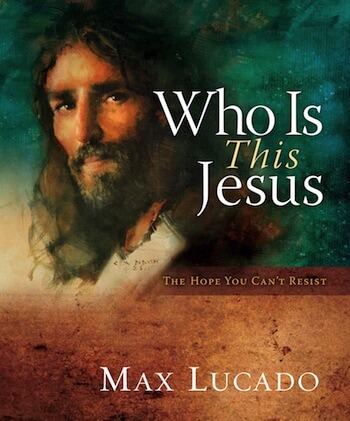There is hope in your difficult situation.”
 That’s how the introduction begins to Max Lucado’s beautifully illustrated hardcover book, Who Is this Jesus: The Hope You Can’t Resist.
That’s how the introduction begins to Max Lucado’s beautifully illustrated hardcover book, Who Is this Jesus: The Hope You Can’t Resist.
The editor’s introduction challenges the readers to recall the worst day of their life and then to take hope in spite of it. Why? Because the Bible meets us where we are and gives us (with a nod to Charles Dickens) hope in the best of times and the worst of times.
The introduction offers biblical examples of those who received hope when they didn’t expect it:
- David, while fleeing from King Saul’s madness, sought refuge in a cave where God became his refuge (Psalm 142:3-5).
- Paul, while recounting his missionary struggles to the Corinthians, testified that he thought himself as good as dead, but God—who raises the dead—rescued him (2 Corinthians 1:8-11).
These biblical examples finally shift to Mary Magdalene, who discovered Jesus’ empty tomb that first Easter Sunday morning.
The Bible tells us of the soldiers who guarded the Christ’s tomb and who witnessed the angel who rolled back the stone that covered the tomb. The soldiers fell to the ground and fainted in fear (Matthew 28:4).
The introduction concludes:
The Bible doesn’t tell us the story of any of these soldiers . . . And yet . . . if the story had been told . . . it might have gone something like this.
Although the conclusions to Who Is this Jesus are super, the book has some snags.
A Story Told as Only Lucado Can
What follows the introduction is a creative and compelling story of what might have happened.
Blending Scripture with creative imagination, Who Is this Jesus tells us of Claudius, a Roman soldier who finds the rag-tag group of disciples huddled in the upper room. He tells what he saw and heard at the site of Jesus’ crucifixion. Claudius then recounts how he and the other soldiers buried Jesus, sealed and guarded the tomb, and then witnessed the resurrection.
A Few Snags
In spite of the great storytelling and fabulous paintings, the book left me with a few problems unresolved:
- The story of Claudius never mentions the only part of the Roman soldiers’ story the Bible does tell us! Namely, after witnessing the angel, “some of the guard” went and told the chief priests what happened:
When they had assembled with the elders and consulted together, they gave a large sum of money to the soldiers, and said, “You are to say, ‘His disciples came by night and stole Him away while we were asleep.’” . . . And they took the money and did as they had been instructed; and this story was widely spread among the Jews, and is to this day. —Matthew 28:12–15
This popular story still had legs in the second century, as noted by Justin Martyr (Dialogue, 108). Granted, if only “some of the guard” reported the events, Claudius could have represented those who didn’t. But it would have been nice for the fictional story to include this historical incident, just as it recorded the events at the cross.
- A minor issue: Lucado calls the upper room “a small room,” but Scripture calls it “large” (Mark 14:15; Luke 22:12). I like that one of the paintings in the book was of the modern Upper Room (built in the Crusader days), which represents the same air space of the original Upper Room.
- The biggest challenge I faced while reading the book was more personal than anything. The book begins by asking the readers to recall their “worst of times” moment. Then the book concludes by pointing the reader to the death and resurrection of Jesus—a historical event. This is fabulous. There is no better place to point anyone.
The problem is that the majority of the book teaches Jesus’ death and resurrection through historical fiction.
That’s historical fiction.
Few tell a story better than Max Lucado. He has mastered the craft. Max’s other books of creative fiction—especially his tremendous “Wemmicks” stories—are wonderful parables that point to timeless truths. (Who Is this Jesus was excerpted from Lucado’s book, Tell Me the Story.)
Granted, Who is This Jesus clearly tells us the story is fiction. But then the book asks the reader to believe its conclusions are true—and to trust in that truth for peace in the worst of times. This may not be a problem for some readers, and that’s great. But it left me uneasy.
Maybe the story will be just the compelling reason a reader might need to turn to God’s Word to find the real story.
Positive Takeaways
The best parts of the book are the illustrations. Absolutely stunning oil paintings from the brush of gifted artist, C. Michael Dudash. Each painting caused me to stop and study it. You can see more of Dudash’s work here.
In the end, Who is This Jesus does point to the true reason any of us can have hope in worst of times. That reason is the resurrection of Jesus Christ from the dead.
Jesus truly is the hope that you can’t resist.
Question: Do you think I’m too hard on this book? You can leave a comment by clicking here.
